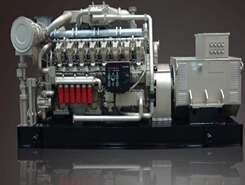典型有机废弃物厌氧发酵产项目,沼气发电工艺流程,厌氧发酵产出沼气之后,行净化和储存,再进入沼气发电系统产生电能,同时回收余热返回预处理系统和厌氧发酵系统。如果余热不够,还需要配套沼气锅炉进行产热(即使余热够用,一般锅炉也都是要上的,用于调试期间及发电机检修期间供热)。同时还应设置应急火炬,用于沼气净化系统或者沼气利用系统故障时,沼气的应急处理。
A typical organic waste anaerobic fermentation production project involves a biogas power generation process. After biogas is produced through anaerobic fermentation, it is purified and stored before entering the biogas power generation system to generate electricity. At the same time, the residual heat is recovered and returned to the pretreatment system and anaerobic fermentation system. If the waste heat is insufficient, it is also necessary to provide a biogas boiler for heat generation (even if the waste heat is sufficient, generally, the boiler is required for heating during commissioning and generator maintenance). At the same time, emergency flares should also be installed for emergency treatment of biogas when the biogas purification system or biogas utilization system fails.
沼气发电技术较为成熟,发电机组有进口的,也有国产的。国产机组相对投资较低,但是发电效率也较低(进口发电机发电效率35%~40%,国产发电机组发电效率25%~35%)。如果发电量较大,电能可成为项目主要收益来源,建议选择进口发电机组。如果项目投资紧张,且发电量较小,可以选择国产发电机组。

The biogas power generation technology is relatively mature, with both imported and domestic power generation units. Domestic units have relatively low investment, but their power generation efficiency is also low (35% - 40% for imported generators, 25% - 35% for domestic generators). If the power generation capacity is large, electric energy can become the main source of income for the project. It is recommended to choose imported power generation units. If the project investment is tight and the power generation capacity is small, domestic power generation units can be selected.
沼气发电系统主要由沼气发电机组、余热回收装置、烟气净化装置组成。发电机以沼气为燃料,一部分热能转化成电能输出,可以用于项目自身或并入电网。还有一部分热能,会通过发动机机体和烟气散发出来(约为总热量的50%~60%),因此可对这部分热能进行回收。回收的热量可用于前端工艺(预处理加热和厌氧罐保温),如果热量不够,可通过沼气锅炉进行补充。发电机组产生的烟气回收完热量之后,进入烟气净化系统,去除烟气中的氮氧化合物,净化后的烟气进行高空排放。
The biogas power generation system is mainly composed of biogas power generation units, waste heat recovery devices, and flue gas purification devices. The generator uses biogas as fuel, and part of the thermal energy is converted into electrical energy for output, which can be used for the project itself or integrated into the power grid. There is also a portion of thermal energy that is emitted through the engine body and smoke (approximately 50% to 60% of the total heat), so this portion of thermal energy can be recovered. The recovered heat can be used for front-end processes (pre-treatment heating and anaerobic tank insulation), and if the heat is insufficient, it can be supplemented by biogas boilers. After the heat is recovered from the flue gas generated by the generator unit, it enters the flue gas purification system to remove nitrogen oxides from the flue gas, and the purified flue gas is discharged at high altitude.
 全国服务热线:
全国服务热线:
 全国服务热线:
全国服务热线: 济南济柴环能燃气发电设备有限公司
济南济柴环能燃气发电设备有限公司



